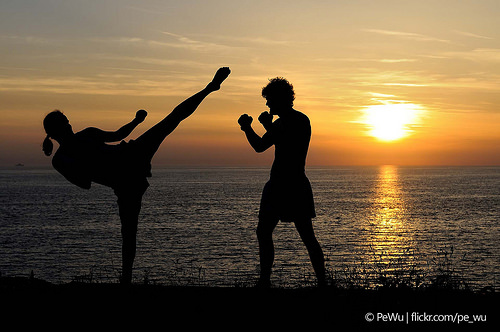Karate is not an ancient art. What we know today as Japanese Karate is only about 100 years old. Indeed it stems from on an older Okinawan tradition called ‘Tode’. But ‘Tode’ changed dramatically to become ‘Karate’. Why? Because Karate had a different purpose than Tode.
Tode was an art of self-defense often taught in secret. Passing on Tode was a family affair: a master usually trained his children and a very limited number of (live in) students. Tode had only one purpose: to teach students self-defense against one or several thugs. There were no competitions.
Karate was introduced in Japan pre World War II. Its main purpose was to prepare the population for war. To this end the government introduced it in schools. The inventors introduced military like drills, ‘ranks’ and uniforms. They stressed physical fitness.
At that time western TV transmissions of boxing matches created some stir in Japan. Hence schools started Karate competitions. They also emphasized the “punch and kick” elements of Karate. To be able to teach masses (including young children) they simplified the art. In the process they removed exceedingly complex or dangerous applications.
When competitions became popular, Karate schools limited their training to those techniques that were successful in competition. And they started to forget how to defend against attacks that were not allowed by competition rules.
Students were of cause not told of this change. And so teachers baited generations of students with alleged defensive super powers. Meanwhile they forgot the true meaning of their art. Today most teachers as well as students don’t know the meaning of the kata (the forms) they are performing. The kata are like coreographed dances to them, beautiful but empty.
Unfortunately when faced with real self-defense situations some Karate practitioners have to learn the hard way that their Karate isn’t really working. As they did never understand the true purpose of their techniques they have never learned them correctly. Their Karate is beautiful but broken.


A sense of purpose
I see the same thing happening with many methods and practices at work. People apply techniques from the text book (or the companies process handbook). But they never really understand why they do it. And because of that the methods can never unfold their true power. This is especially striking with agile methods.
Let me give you an example: a few years back I attended a daily scrum meeting. The rules of scrum say that everybody should be standing. Furthermore everybody should report within two minutes what she did yesterday and is about to do today. I remember the scene vividly: There were more than twenty people in the room, all with their backs to the wall. Everybody reported dutifully, but nobody listened. What had happened?
Daily scrum meetings assume that the entire team works on the same issue. In that situation it is crucial to have everybody in the loop. The team I was seeing was a team only on paper: every engineer had her own tasks and goals. That is why there was no need to know regarding the current work progess of others. The team had made a “small” mistake elsewhere that rendered the daily scrum utterly useless.
The ensuing though process was roughly this:
Me: “This daily scrum meeting, what is it for?”
Team: “To exchange status information about our tasks.”
Me: “What do you need this information for?”
Team: “…No idea!”
Me: “What would have to happen to create a need?”
Team: “If we would work together more…”
Me: “What would we have to do to work together more?”
Team: “Cut the team in three. Start working on the tasks toghether.”
Of cause we could just have cancelled the daily meetings. But in the end it seemed more sensible to increase team work.
The lesson
To unleash the power of your processes and methods dig deep to understand their inner logic and raison d’être. Check whether the way you execute them is actually compatible with this logic. This makes your tools more robust and effective. That is why purpose, the question of why, is much more long-term and growth oriented than process, the question of how.
In my life as a martial artist (as well as in Kikentai Management) I have made it a priority to keep asking why. I am only satisfied with a technique or an application if I get the impression that it will work for its ultimate purpose (in this case self-defense). As an example here you can watch me showing applications of the basic Shotokan kata Heian Sandan (sorry, German soundtrack only).

Leave a Reply